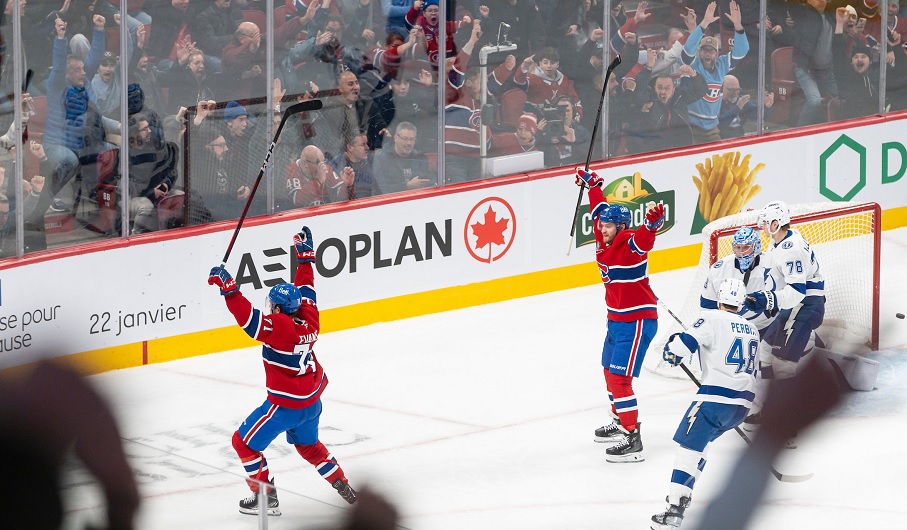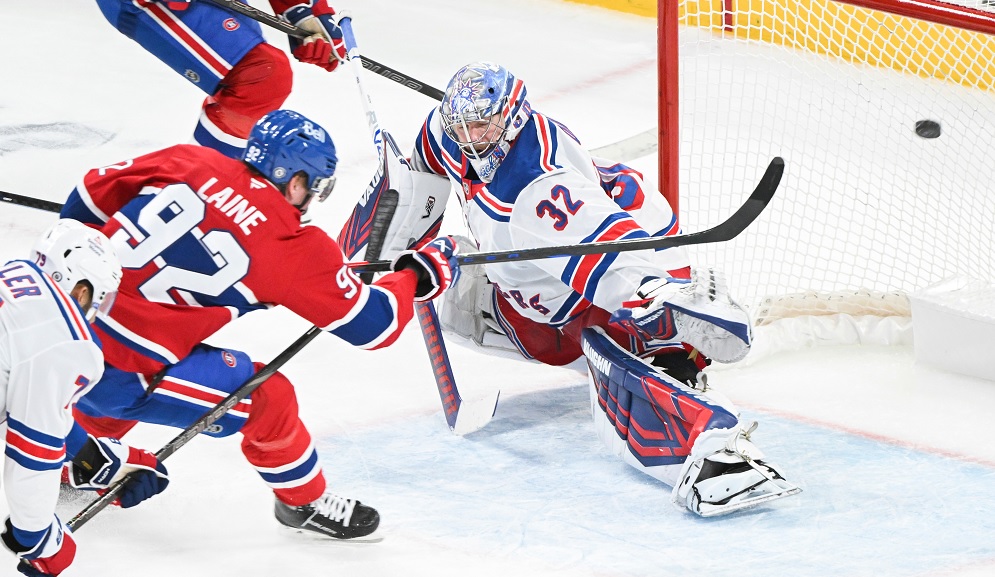HabsWorld.net --
An educated guess.
Essentially, the NHL entry draft can be summed up in those three words. At no point in league history has so much time and resources gone into a single event. All of the team’s now employ large amateur scouting staffs, all just for this day. To say that team’s go into the draft prepared would be a major understatement. Each available prospect is analyzed and scrutinized in every aspect of his life, both off and on the ice.
But even with all of this preparation, all this time spent scouring the globe by each team’s scouting staff; there are very few sure things. Sure there are players like Sidney Crosby picked first overall some years, but for every sure thing there are many more Alexandre Daigle’s. In essence what the teams are picking is the potential of each individual player. The main objective of the draft for each team is to successfully project what today’s 18 year old prospect will develop into over the next couple of years. Will he be able to mature and emerge into a player who can become a valuable member of your team?
This is where the success of the draft is crucial. The foundation of your team’s future success is laid that day at that table. However, if your team is unsuccessful at the draft, in that your picks don’t become the future foundation of your squad as predicted, you can quickly become stuck in mediocrity.
With the benefit of hindsight it’s easy to see how the summer of 2001 represented a fundamental shift in the philosophy of the Montreal Canadiens. With all the feeling of a mercy killing, the tenure of Rejean Houle as the team’s general manager had finally been put into the rearview mirror.
In his place stood the teams new general manager; Andre Savard. The task facing Savard was a daunting one, to say the least. The Montreal Canadiens organization that he had inherited was but a shell of it’s former self. The team had failed to make the playoffs the previous three seasons and was coming off a season in which they finished last in their division, after only winning 28 games. In addition, the farm system was also light on talent due to poor drafting and weak personnel decisions.
There were many reasons for the Canadiens slide in the years preceding the millennium. Poor trades had gutted the team of its best players, but what compounded the problem was the utter lack of new players coming up through the system.
Nowhere was this more apparent than in the Canadiens lack of success with their first round picks. First round picks represent the best of all the amateur talent available. The majority of today’s NHL superstars where selected in the first round of the draft. No area of the draft is more crucial for any team than their first round draft pick.
In 1993 after winning their last Stanley Cup, the Canadiens selected Saku Koivu in the first round of that springs draft. Over the next seven years however, the Canadiens first round picks failed to live up to any of the expectations placed on them.
1994 – Brad Brown, played 13 games with the Canadiens, scored no points
1995 – Terry Ryan, played 8 games with the Canadiens, scored no points
1996 – Matt Higgins, played 57 games with the Canadiens, scored three points
1997 – Jason Ward, played 105 games with the Canadiens, scored twenty points
1998 – Eric Chouinard, played 13 games with the Canadiens, scored four points
1999 – No pick
2000 – Ron Hainsey, played 32 games with the Canadiens, scoring two points
With his first pick, Savard needed to make a statement, and he did. Savard was able to lay out the groundwork that the Habs use to this day at the draft table. Savard based his decision on the three things that the Canadiens look for in all their draft picks that they have selected ever since; size, skill, and character.
With the seventh pick of the 2001 entry draft, Savard selected defenseman Mike Komisarek from the University of Michigan. It didn’t take long to realize that a new age had dawned for the Canadiens at the draft. Just from looking at him, one could tell that the Canadiens philosophy had changed.
Standing 6′ 4” and weighing 241 pounds, Komisarek was the most physically imposing player that we’d seen in a Habs uniform in a long time. And unlike previous selections, the Canadiens were willing to be patient and let Komisarek grow into his future role with the team. In effect, Komisarek became the template for the Habs picks to follow.
First round picks 1994 – 2000, played 228 combined games with the Canadiens, scoring 29 points
2001 – Mike Komisarek, has played 220 games with the Canadiens, scoring 30 points
Now a little over six years later, the Canadiens future looks far more promising. Half of the current Habs team is composed of players drafted in the past six years. Now ranked by the website hockeysfuture.com as having the second best farm system in the NHL, this years training camp was a showcase for the teams young talent. Having won the Calder Cup the year before, this years camp saw competition from many young prospects ready to make the next step.
All of that began with Mike Komisarek. Now entering his fifth year with the Canadiens, Komisarek as emerged as the team’s shutdown defenseman. Arguably, the Canadiens most valuable defenseman not named Andrei Markov; Komisarek excels at playing the physical game, a rough, mean, hard-hitting stay at home defenseman, Komisarek has slowly emerged as one of the team’s leaders.
But at the start it was a different story.
One of the joys of following a hockey team, every year, one game at a time is that you get to see the privilege of watching players grow in stature right in front of our eyes. When Komisarek first came up with the Canadiens, he was usually the sixth defenseman and given a limited role with the team. He was able to assert his physical prowess, while learning to develop his defensive skills.
As the years have progressed Komisarek’s game has gone to the next level as he’s been able to harness his talent, and slowly but surely he has found himself as one of the most valuable players on the team.
Last year, head coach Guy Carbonneau remarked to the Montreal Gazette;
“I thought Mike improved a lot last year, he understands the game better, he’s a big boy, and in the minors he wanted to hit everything, and make everybody feel his presence. But he got out of position a lot.”
“I think now he understands what’s in front of him, he reacts better to those plays, doesn’t get caught as much going to give the big hit and giving up the 2 on 1. He’s more patient that way, he’s playing with more confidence too, and that comes from experience and playing.”
Last year Komisarek was able to blossom into what the Canadiens had envisioned when they selected him in the 2001 draft. He posted personal career highs in games played (82), goals (4), assists (15), and points (19). In addition, to posting a plus seven rating on a team that was the worst in the league five on five, Komisarek’s 248 hits ranked second amongst all NHL defenseman.
And while the Canadiens have been able to nurture and patiently wait for Komisarek to mature into his current role with the team, there were other factors at work.
Like his teammate and neighbor, Chris Higgins, Komisarek works throughout the summer with Greg Parks, the mental conditioning coach at institute 3E in Long Island. While there has been a tremendous amount of attention paid to the physical part of the program, led by personal trainer; Joe DiFlorio, the mental aspects of the program have not received nearly as much press.
At the Institute 3E (the three E’s stand for exercise, education, and empowerment) the physical regiment is augmented by such mental tools as yoga and meditation that focus on giving the players the mental tools to succeed. There is an emphasis placed on self-empowerment and on the consistent use of self motivating words and phrases, both on and off the ice, with personal reinforcement by Parks to follow throughout the season.
Institute 3E’s Park explained to the Gazette’s Dave Stubbs;
“Both (Higgins and Komisarek) had returned to their off season home last April carrying their Habs hurts with them, and both returned to Montreal this month (training camp) with a renewed attitude and commitment to winning and becoming leaders.”
With the departure of Sheldon Souray and Craig Rivet, Komisarek began this summer to assume some of the leadership vacuum that had developed in their absence. Not only did Komisarek spend significant parts of his summer enjoying what Montreal has to offer, but he was one of the instructors at the Canadiens first summer hockey camp for children.
More importantly, at this summer’s development camp for 24 of the Canadiens top prospects, it was Komisarek who spoke to these young prospects about what it took to be a Montreal Canadiens and the responsibilities that all that entails. It had only been a short six years ago that he had been one of those kids.
Mike Komisarek has evolved from an eighteen year old prospect into one of the young leaders of the Montreal Canadiens. He has become everything that the Canadiens had hoped what he would be when he was drafted by the team in 2001. He has seen the Canadiens emerge from their malaise, and is one of the main reasons for hope about the future. A hope that didn’t exist just a few short years ago.

